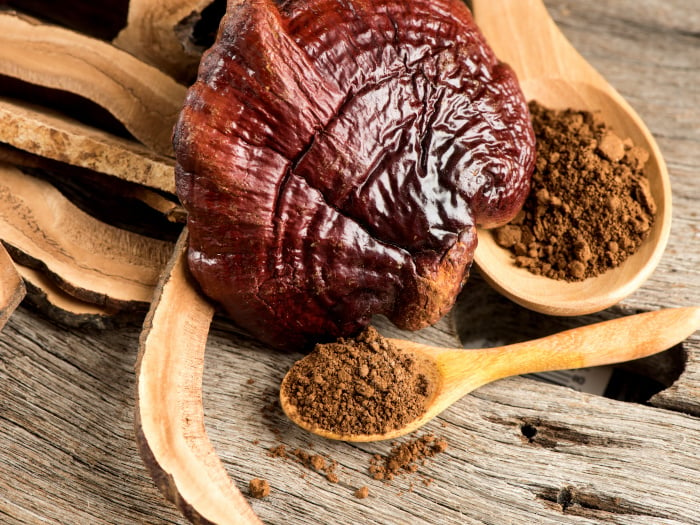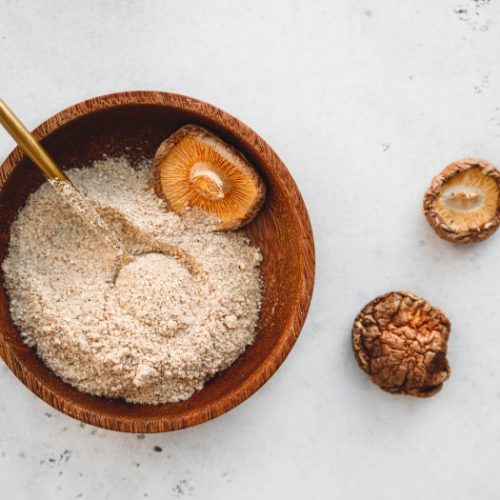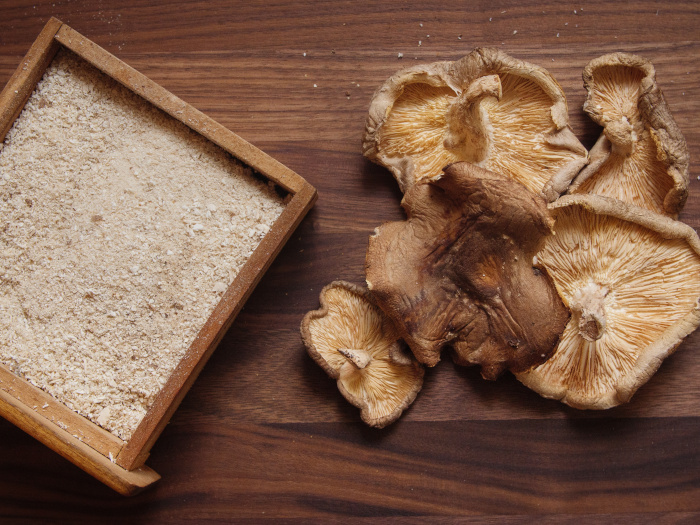We all know that culinary scientists and food connoisseurs have declared umami as the fifth taste, after salt, sweet, sour, and bitter. To put it succinctly, umami is that indescribable taste that not only lends the food a meaty flavor but also elevates the whole gastronomical experience, leaving you craving for more. The perfect example of umami is fish sauce, which is often made from anchovies, salt, and water. But what about those who are vegetarian or vegan? Well, worry not as you can always use mushroom powder as an indispensable substitute that can be added to your dish as a seasoning blend. [1] [2]
What is Mushroom Powder?
Literally speaking, mushroom powder is dried mushrooms pulverized into a powdered form. You can use any type of dietary mushroom to make this powder. It is known for its umami flavor. To know the different varieties, read our article, 15 Types Of Mushrooms & How To Use Them. Dehydrating the mushrooms is a great way to store the fungi and increase their shelf life in the long run. To turn them into powder, all you need to do is grind the dehydrated mushrooms using a food processor. The flavor of the mushrooms tends to concentrate as they dry up. When added to the dish, they give out an intense earthy, and meaty flavor. [3]

You need to pulverize dried mushrooms to make mushroom powder. Photo Credit: Shutterstock
Mushroom Powder Nutrition
According to the USDA data, mushroom powder is rich in energy, fiber, water, and protein. Additionally, they are a good source of calcium, iron, phosphorus, magnesium, potassium, copper, and sodium. It holds some important vitamins such as vitamin C, niacin, folate, vitamin A, beta carotene, vitamin K, and low quantities of thiamin, riboflavin, and vitamin B-6 too. Such a rich nutritional profile makes mushroom powder a healthy addition to your diet. Apart from this, their carb and calorific profile go as follows:
- Carbs in powdered mushroom: A 100 gm serving of mushroom powder consists of 65 gm of carbs.
- Powdered mushroom calories: A 100 gm serving of mushroom powder contains around 328 calories.
Health Benefits Of Powdered Mushroom
The health benefits of powdered mushrooms depend on the type of mushroom used to make the powder. Say, for instance, reishi mushrooms are used to give the immunity a boost, whereas shiitake mushroom consists of an important soluble dietary fiber known as b-glucan that helps one stay full for a long period, further aiding in weight management. Given their nutrient profile, mushrooms are a wholesome addition to your diet, however, if not taken in moderation, they could result in some potential side effects. To understand the benefits and side effects of some of the most commonly used mushrooms, give the following articles a read. [4] [5]
- Mushroom: Top Benefits & Side Effects
- 5 Proven Health Benefits Of Maitake Mushrooms
- 7 Best Benefits Of Porcini Mushrooms
- Cremini Mushrooms: Nutrition & Benefits
- Top 7 Benefits Of Chaga Mushrooms
- 12 Surprising Benefits Of Turkey Tail Mushrooms
- 12 Proven Benefits Of Shiitake Mushrooms
- 9 Proven Benefits Of Reishi Mushrooms
Having said that, there are still some differences in consuming the mushrooms as they are vis a vis in their dehydrated & pulverized form. First, mushrooms have a ton of water in them which gets lost in the process of dehydration. Second, when they are compressed in the powdered form, their nutrients invariably get more concentrated. [6]
How To Make Mushroom Powder?
It is fairly simple to make mushroom powder at home. Let us look at the recipe in detail.

Mushroom Powder Recipe
Ingredients
- 1.5-2 ounce of dried shitake mushrooms
- 1 tbsp of chili pepper flakes
- 2/3 cup of Himalayan salt or kosher salt
- 3 tsp of dried oregano
- 1 tsp of freshly ground black pepper
Instructions
- To make mushroom powder, you need to combine all of the above ingredients in the quantities mentioned and blend/ grind it in a food processor or blender. Continue blending it till it turns into a fine powder.
- Once done, you can store it in an airtight container, which you can then keep in a cool place for days together. Use a fine-mesh strainer to pour the powder into the glass container. Add a pinch of the powder to soups, salads, pasta, and the like to get the delicious umami flavor.

Notes
How To Use Mushroom Powder?
Powdered mushrooms can be added to almost anything, which only goes to show how versatile it is. It has a mellow and earthy flavor that elevates the taste of any dish it is added to. Here are a few ways in which they can be used.
- Seasoning blend: Mushroom powder is used as a seasoning blend in soups, salads, pasta sauce, and even scrambled eggs. The most common types of mushrooms that are used to make the powder are porcini, white button, and shiitake mushrooms. You can also add it to cutlets and steaks before they are put on the grill to be cooked.
- Medicinal blend: Mushrooms like reishi are known to reduce stress, boost the immune system, improve sleep, and reduce fatigue. Adding a pinch of this powder to your beverage is likely to benefit your health. However, not much scientific information is available about its dosage. Hence, it is always advisable to seek advice from a medical practitioner before consuming it to avoid any kind of potential side effects. [7]

